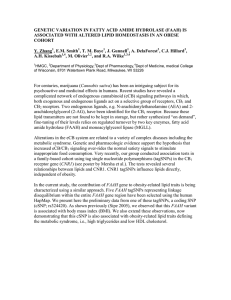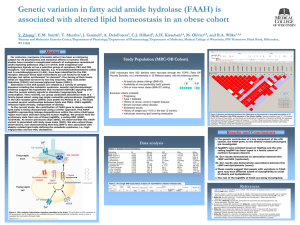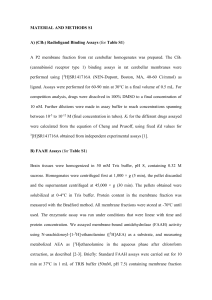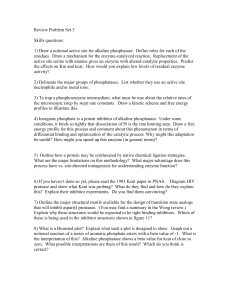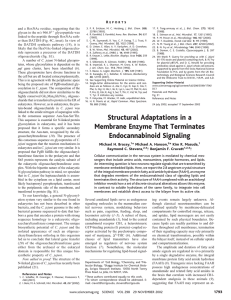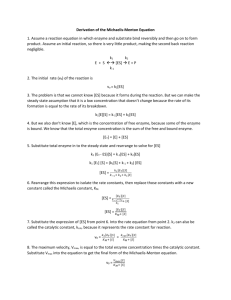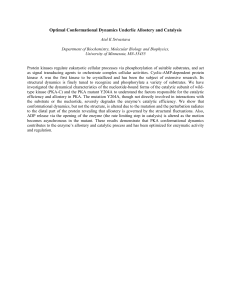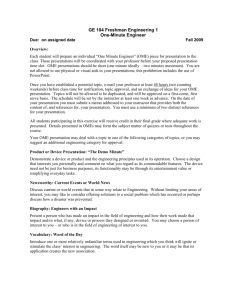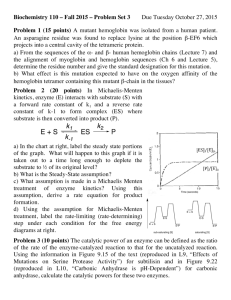Fatty Acid Amide Hydrolase Competitively Degrades Bioactive Amides and Esters
advertisement
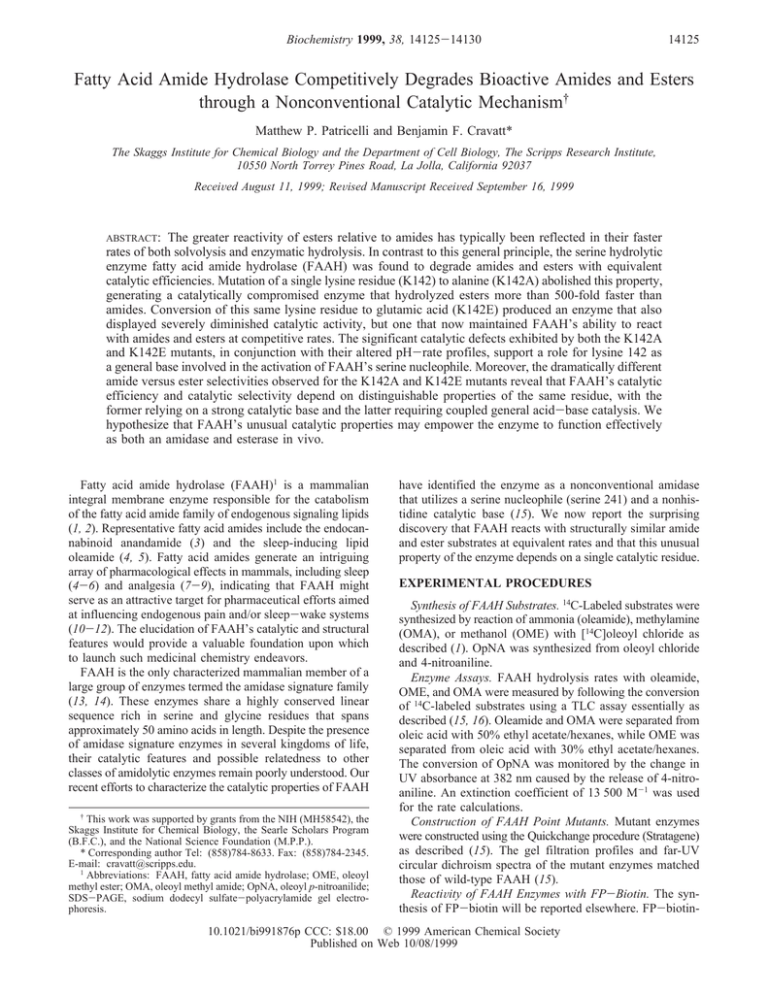
Biochemistry 1999, 38, 14125-14130
14125
Fatty Acid Amide Hydrolase Competitively Degrades Bioactive Amides and Esters
through a Nonconventional Catalytic Mechanism†
Matthew P. Patricelli and Benjamin F. Cravatt*
The Skaggs Institute for Chemical Biology and the Department of Cell Biology, The Scripps Research Institute,
10550 North Torrey Pines Road, La Jolla, California 92037
ReceiVed August 11, 1999; ReVised Manuscript ReceiVed September 16, 1999
ABSTRACT: The greater reactivity of esters relative to amides has typically been reflected in their faster
rates of both solvolysis and enzymatic hydrolysis. In contrast to this general principle, the serine hydrolytic
enzyme fatty acid amide hydrolase (FAAH) was found to degrade amides and esters with equivalent
catalytic efficiencies. Mutation of a single lysine residue (K142) to alanine (K142A) abolished this property,
generating a catalytically compromised enzyme that hydrolyzed esters more than 500-fold faster than
amides. Conversion of this same lysine residue to glutamic acid (K142E) produced an enzyme that also
displayed severely diminished catalytic activity, but one that now maintained FAAH’s ability to react
with amides and esters at competitive rates. The significant catalytic defects exhibited by both the K142A
and K142E mutants, in conjunction with their altered pH-rate profiles, support a role for lysine 142 as
a general base involved in the activation of FAAH’s serine nucleophile. Moreover, the dramatically different
amide versus ester selectivities observed for the K142A and K142E mutants reveal that FAAH’s catalytic
efficiency and catalytic selectivity depend on distinguishable properties of the same residue, with the
former relying on a strong catalytic base and the latter requiring coupled general acid-base catalysis. We
hypothesize that FAAH’s unusual catalytic properties may empower the enzyme to function effectively
as both an amidase and esterase in vivo.
Fatty acid amide hydrolase (FAAH)1 is a mammalian
integral membrane enzyme responsible for the catabolism
of the fatty acid amide family of endogenous signaling lipids
(1, 2). Representative fatty acid amides include the endocannabinoid anandamide (3) and the sleep-inducing lipid
oleamide (4, 5). Fatty acid amides generate an intriguing
array of pharmacological effects in mammals, including sleep
(4-6) and analgesia (7-9), indicating that FAAH might
serve as an attractive target for pharmaceutical efforts aimed
at influencing endogenous pain and/or sleep-wake systems
(10-12). The elucidation of FAAH’s catalytic and structural
features would provide a valuable foundation upon which
to launch such medicinal chemistry endeavors.
FAAH is the only characterized mammalian member of a
large group of enzymes termed the amidase signature family
(13, 14). These enzymes share a highly conserved linear
sequence rich in serine and glycine residues that spans
approximately 50 amino acids in length. Despite the presence
of amidase signature enzymes in several kingdoms of life,
their catalytic features and possible relatedness to other
classes of amidolytic enzymes remain poorly understood. Our
recent efforts to characterize the catalytic properties of FAAH
†
This work was supported by grants from the NIH (MH58542), the
Skaggs Institute for Chemical Biology, the Searle Scholars Program
(B.F.C.), and the National Science Foundation (M.P.P.).
* Corresponding author Tel: (858)784-8633. Fax: (858)784-2345.
E-mail: cravatt@scripps.edu.
1 Abbreviations: FAAH, fatty acid amide hydrolase; OME, oleoyl
methyl ester; OMA, oleoyl methyl amide; OpNA, oleoyl p-nitroanilide;
SDS-PAGE, sodium dodecyl sulfate-polyacrylamide gel electrophoresis.
have identified the enzyme as a nonconventional amidase
that utilizes a serine nucleophile (serine 241) and a nonhistidine catalytic base (15). We now report the surprising
discovery that FAAH reacts with structurally similar amide
and ester substrates at equivalent rates and that this unusual
property of the enzyme depends on a single catalytic residue.
EXPERIMENTAL PROCEDURES
Synthesis of FAAH Substrates. 14C-Labeled substrates were
synthesized by reaction of ammonia (oleamide), methylamine
(OMA), or methanol (OME) with [14C]oleoyl chloride as
described (1). OpNA was synthesized from oleoyl chloride
and 4-nitroaniline.
Enzyme Assays. FAAH hydrolysis rates with oleamide,
OME, and OMA were measured by following the conversion
of 14C-labeled substrates using a TLC assay essentially as
described (15, 16). Oleamide and OMA were separated from
oleic acid with 50% ethyl acetate/hexanes, while OME was
separated from oleic acid with 30% ethyl acetate/hexanes.
The conversion of OpNA was monitored by the change in
UV absorbance at 382 nm caused by the release of 4-nitroaniline. An extinction coefficient of 13 500 M-1 was used
for the rate calculations.
Construction of FAAH Point Mutants. Mutant enzymes
were constructed using the Quickchange procedure (Stratagene)
as described (15). The gel filtration profiles and far-UV
circular dichroism spectra of the mutant enzymes matched
those of wild-type FAAH (15).
ReactiVity of FAAH Enzymes with FP-Biotin. The synthesis of FP-biotin will be reported elsewhere. FP-biotin-
10.1021/bi991876p CCC: $18.00 © 1999 American Chemical Society
Published on Web 10/08/1999
14126 Biochemistry, Vol. 38, No. 43, 1999
labeled FAAH samples were analyzed with a Western blot
assay, and values of kobs/[I] were determined as follows.
FAAH samples were incubated at 5 µg/mL (80 nM) with
several concentrations of FP-biotin (1-50 µM), quenched
with SDS-PAGE loading buffer at various times, resolved
by SDS-PAGE and electroblotting, and visualized with an
avidin-horseradish peroxidase conjugate. The time required
to reach 50% labeled protein was estimated by comparing
time points to a standard consisting of a 2-fold dilution of
FAAH fully labeled with FP-biotin. The values of kobs/[I]
for the K142E and K142A mutants represent the average of
duplicate trials at a minimum of four concentrations of FPbiotin.
Isolation of FAAH Acyl-Enzyme Intermediates. Acylenzyme intermediates of FAAH were isolated essentially as
described previously for the isolation of ethoxy oleoyl
fluorophosphonate-labeled FAAH (15). Briefly, each enzyme
(2 µM) was incubated with the indicated substrate (150 µM)
for a time equal to roughly 5-10 turnovers in order to reach
steady state before quenching the reaction with trichloroacetic
acid. The proteins were subjected to SDS-PAGE and
digested in gel with trypsin, and the resulting peptides
separated by reverse-phase HPLC.
Determination of k2 Values for the K142E Mutant.
Saturating concentrations of 14C-labeled substrates (150 µM)
were incubated with the K142E mutant (6 µM) for various
times before quenching with SDS-PAGE loading buffer.
The protein samples were bath sonicated for 5 min, heated
at 90 °C for 30 s, resolved by SDS-PAGE, transferred to a
poly(vinylidene difluoride) membrane, and protein-associated
radioactivity quantified by phosphorimaging (Packard). The
kinetics of acyl-enzyme accumulation were fit using the
assumption that the equilibration of the noncovalent ES
complex is a rapid process such that enzyme freed through
deacylation rapidly returns to the ES state. Thus, the kinetics
for accumulation of acylated enzyme can be simplified to
the kinetics of a simple equilibrium between two states: the
noncovalent Michaelis complex ES and the acylated enzyme
ES*. The kinetics of this scheme can be described by the
following equation: [ES*]t ) [E]T - {[E]Tk2/(k2 + k3)}{(e-(k2+k3)t) + (k3/k2)}; where [ES*]t is the amount of
radioactivity observed at time, t, corresponding to acylated
enzyme; [E]T is the maximal amount of radioactivity
observed for 100% acylated enzyme (i.e., the plateau value
for oleamide or OME, since k2 . k3); and k2 and k3 are the
acylation and deacylation rate constants, respectively. The
value of k3 was determined from steady-state measurements
of oleamide hydrolysis. [E]T and k2 were independent
variables minimized by the fitting process in the case of
oleamide and OME. The value of [E]T obtained was then
used for the fitting of k2 for OMA and OpNA.
RESULTS
In all studies described herein, a rat FAAH protein lacking
its N-terminal 39 amino acids was used. This modification
removed FAAH’s predicted transmembrane domain, the
deletion of which was previously found to leave FAAH’s
catalytic and membrane-binding properties unaltered while
at the same time facilitating the recombinant enzyme’s
purification (16). For the sake of clarity, we refer to this
N-terminal deletion protein as FAAH throughout the manuscript.
Accelerated Publications
Table 1: Catalytic Properties of FAAH at pH 9.0
substrate
kcat (s-1)
Km (µM)
kcat/Km (µM-1 s-1)
oleamide
OMA
OpNA
OME
9(1
1.9 ( 0.1
0.17 ( 0.02
2.8 ( 0.1
37 ( 7
9(2
22 ( 3
21 ( 3
0.24
0.21
7.7 × 10-3
0.13
Scheme 1: Standard Kinetic Scheme for Serine Hydrolasesa
a In this scheme, where acylation is controlled by k , deacylation by
2
k3, and dissociation constant Ks ) k-1/k1, E is the enzyme, S is the
substrate, ES is the noncovalent Michaelis complex, ES* is the acylenzyme intermediate, and P1 and P2 are products.
The basic kinetic parameters, kcat and Km, for FAAHmediated hydrolysis of various ester and amide substrates
are presented in Table 1. Interestingly, the kcat and kcat/Km
values for the hydrolysis of oleamide were slightly but
significantly higher than those for the hydrolysis of oleoyl
methyl ester (OME, Table 1). The kcat and Km values for the
hydrolysis of oleoyl methyl amide (OMA) were comparable
to those for OME hydrolysis, indicating that the methyl group
of OME did not directly hinder catalysis or productive
binding. The overall similarity in measured kcat values for
FAAH’s amide and ester substrates raised the possibility that
the rate-limiting step for their reaction might be the deacylation of a common acyl-enzyme intermediate (ES*, Scheme
1). However, in deacylation rate-limiting reactions, lower
Km values are observed for those substrates with faster
acylation rates (k2 values), in turn leading to higher kcat/Km
values (assuming similar values of Ks; 17, 18). Thus, the
similar Km and kcat values measured for oleamide, OMe, and
OMA supported their comparable acylation rates with FAAH.
Substrate competition experiments with oleamide and OME
were also conducted, and these studies confirmed the relative
Km and kcat/Km values reported in Table 1 (data not shown).
FAAH’s similar catalytic efficiency with oleamide, OME,
and OMA contrasted sharply with the substrate selectivities
displayed by most serine proteases, which tend to react with
esters at rates several orders of magnitude faster than amides
(18-22). FAAH’s peculiar substrate selectivity was further
exposed with oleoyl p-nitroanilide (OpNA). Due to the
electron-withdrawing nature of the p-nitrophenyl group,
p-nitroanilides are typically much more reactive substrates
than their unactivated amide counterparts (18, 19). However,
FAAH hydrolyzed OpNA at a substantially slower rate than
oleamide, despite both substrates displaying similar Km
values. The reduced kcat value observed for OpNA indicated
that this substrate was acylation rate limiting, thus making
Km ) Ks. The similarity of OpNA’s Ks value to the Km values
for oleamide, OMe, and OMA further supports the conclusion
that the comparable kcat/Km values for these substrates reflect
their similar acylation rates (k2) rather than compensatory
differences in Ks and k2 values among the substrates. In
summary, the leaving group dependence of kcat (and analogously, k2) displayed by FAAH with the substrates shown
in Table 1 (amide g ester > anilide) differed markedly from
the typical solution hydrolysis and protease acylation rates
observed with these classes of compounds (ester > anilide
> amide).
Accelerated Publications
Biochemistry, Vol. 38, No. 43, 1999 14127
Table 2: Catalytic Properties of the K142A Mutant at pH 9.0
substrate
kcat (s-1)
oleamide
OMA
OpNA
OME
(2.6 ( 0.3) × 10
(1.0 ( 0.1) × 10-4
0.012 ( 0.001
0.15 ( 0.01
-4
Km (µM)
kcat/Km (µM-1s-1)
20 ( 5
41 ( 8
63 ( 9
12 ( 3
1.3 × 10-5
2.4 × 10-6
1.9 × 10-4
0.013
Table 3: Catalytic Properties of the K142E Mutant
substrate
kcat (s-1)a
oleamide
OMA
OpNA
OME
(6.4 ( 0.8) ×
(3.1 ( 0.3) × 10-4
(2.0 ( 0.2) × 10-4
(5.2 ( 0.6) × 10-4
a
10-4
k2 (s-1)b
Km (µM)
0.024 ( 0.002
(3.1 ( 0.3) × 10-3
(3.0 ( 0.3) × 10-4
0.032 ( 0.003
<10
<10
32 ( 4
<10
kcat determined at pH 9.0. b k2 determined at pH 6.5.
Table 4: Relative Substrate Selectivities of FAAH and K142
Mutants
kcat/(kcat oleamide)
k2/(k2 oleamide)
substrate
FAAH
K142A
K142E
oleamide
OMA
OpNA
OME
1
0.2
0.02
0.3
1
0.4
50
600
1
0.2
0.02
1.3
To explore the molecular mechanism by which FAAH
normalized the acylation rates of its ester and amide
substrates, we characterized a series of missense mutants of
the enzyme for altered patterns in their relative substrate
selectivities. In each of these mutants, a single, highly
conserved residue was replaced with alanine (S217A, S218A,
S241A, and K142A), resulting in an enzyme with a greatly
diminished kcat value for oleamide hydrolysis (15). The three
serine mutants displayed similar degrees of catalytic deficiency with ester, anilide, and amide substrates (data not
shown), indicating that these residues do not significantly
impact FAAH’s substrate selectivity. In contrast, the K142A
mutant exhibited a dramatic loss in oleamide hydrolase
activity (a 35 000-fold reduction in kcat), while maintaining
5-10% of wild type activity with OME and OpNA at pH
9.0 (Table 2). The altered substrate selectivity of the K142A
mutant resulted in hydrolysis rates for OpNA and OME that
exceeded oleamide hydrolysis by approximately 50- and 600fold, respectively (Table 4). Thus, mutation of a single
conserved lysine residue transformed FAAH’s unusual
substrate selectivity (amide g ester > anilide) into a preferred
order of reactivity compatible with the solvolysis rates of
these compounds (ester > anilide > amide).
The pH dependence of kcat for OME hydrolysis by the
K142A mutant showed a linear dependence on [OH-] with
a slope of 0.9 (Figure 1A). Similar pH dependencies were
found for the K142A enzyme with oleamide and OpNA (data
not shown). These pH-rate profiles contrasted dramatically
with those of FAAH whose kcat showed dependence on a
basic residue with a pKa of 7.9 (Figure 1A) (15). Neither
enzyme exhibited significant changes in Km values over the
pH range investigated. The greatly reduced amidase activity
of the K142A mutant coupled with its altered pH-rate profile
were consistent with a role for lysine 142 in the basecatalyzed deprotonation of FAAH’s serine nucleophile (19,
23-25). In support of this notion, the reactivity of the K142A
mutant with a biotin-tagged fluorophosphonate inhibitor
FIGURE 1: pH profiles for kinetic parameters of FAAH and lysine
142 mutants. (A) The pH dependence of kcat observed for FAAH
with oleamide (diamonds) and the K142A mutant with OME
(triangles), and the pH dependence of k2 observed for the K142E
mutant with oleamide (open circles). Single-residue ionization
models were used to fit the pH dependence of FAAH and the
K142E mutant, resulting in pKa values of 7.9 and 5.7, respectively.
The pH dependence of kcat for the K142A mutant was fit to a line
with a slope of 0.9. (B) Western blot depicting the FP-biotin
reactivities of the K142A and K142E mutants at various pH values.
For these studies, 50 µM FP-biotin was reacted with 80 nM mutant
enzyme for 10 min, and labeling was detected with an avidinhorseradish peroxidase conjugate. (C) Structure of FP-biotin.
(FP-biotin; Figure 1C) was reduced over 1000-fold relative
to FAAH at pH 9.0 (kobs/[I]K142A ) 64 ( 10 M-1 s-1 versus
kobs/[I]FAAH > 1.4 × 105 M-1 s-1) and showed a dramatic
pH dependence that mirrored the pH dependence of the
mutant enzyme’s catalytic activity (Figure 1B).
To further investigate the role of lysine 142 in FAAH’s
catalytic mechanism, a mutant enzyme was generated in
which this residue was converted to glutamate (K142E).
Mutant enzymes in which lysine 142 was replaced with
histidine or arginine were created as well, but these proteins
proved structurally defective and were not studied further.
The steady-state kinetic properties of the K142E mutant with
various oleoyl substrates are presented in Table 3. In general,
the kcat values of this enzyme were 3-4 orders of magnitude
lower than those of FAAH. Moreover, the K142E mutant’s
similar kcat and low Km values for oleamide, OMA, and OME
suggested that the enzyme hydrolyzed these substrates in a
deacylation rate-limiting manner. In support of this notion,
relatively large quantities of an acyl-enzyme intermediate
were isolated for this mutant enzyme from steady-state
reactions with each substrate (Figure 2). In contrast, the levels
of acyl-enzyme isolated for FAAH from steady-state reactions with oleamide and OME were significantly lower
(Figure 2), indicating a predominantly acylation or mixed
acylation/deacylation rate-limited reaction for the wild-type
enzyme with these substrates.
The acylation rate constants (k2) for the K142E mutant
with oleamide, OME, OMA, and OpNA were determined
by measuring the rate of presteady-state accumulation of 14Clabeled acyl-enzyme in the presence of saturating concentrations of 14C-labeled substrates (Figure 3 and Table 3). The
14128 Biochemistry, Vol. 38, No. 43, 1999
Accelerated Publications
FIGURE 3: Kinetics of acyl-enzyme accumulation for the K142E
mutant with oleamide and OME. The K142E mutant was incubated
with [14C]oleamide (open circles) or [14C]OME (closed circles).
Acylated protein was separated from unbound substrate by SDSPAGE and transferred to a PVDF membrane. [14C]acyl-enzyme was
quantified by phosphorimaging. The acylation rate constants (k2)
were determined by nonlinear least-squares regression.
FIGURE 2: Identification of acyl-enzyme intermediates for FAAH
and the K142E mutant. 75 µg of the K142E mutant (A, C) or FAAH
(B, C) were incubated in the presence (dashed traces in A and B)
or absence (solid lines in A and B) of 200 µM OME prior to
digestion with trypsin and separation of the resulting peptides by
HPLC. Traces in A and B were offset by 0.25 min for clarity. The
peptide containing FAAH’s serine nucleophile S241 (residues 213243) eluted at 57 min (A, B) as judged by electrospray mass
spectrometry (15). For the wild-type enzyme, this peak coeluted
with a peptide containing residues 131-142, which was shifted to
a later elution time for the K142E mutant. In the presence of OME,
a significant reduction in the peak at 57 min was observed for both
enzymes (dashed lines in A and B). This decrease correlated with
the presence of a novel peak eluting at 93 min (C), which was
identified by tandem electrospray mass spectrometry as residues
213-243 plus one bound acyl chain of OME on S241. For both
FAAH and the K142E mutant, reactions with oleamide produced
similar levels of acyl-enzyme to those found for reactions with
OME.
acylation rates for the K142E variant with these substrates
were 100-600 times slower than their respective hydrolysis
rates with FAAH. Interestingly however, the K142E mutant
was acylated by OME and oleamide at nearly equivalent rates
that in turn exceeded the acylation rate of OpNA by
approximately 50-fold. Thus, the unusual acylation specificity
of FAAH was retained in the K142E variant despite this
mutant’s significantly reduced catalytic efficiency.
The pH dependence of k2 for the K142E mutant showed
little change from pH 7-9 and decreased below pH 7 (Figure
1A). A similar pH dependence was observed for kcat (data
not shown) and the enzyme’s reactivity with FP-biotin
(Figure 1B). These results indicated that for the K142E
mutant both acylation and deacylation were governed by a
residue with a pKa < 6, consistent with a role for glutamate
142 as the catalytic base in this enzyme. Notably, the FPbiotin reactivity of the K142E mutant was comparable to
that of the K142A variant at pH 9.0 (kobs/[I]K142E ) 68 ( 10
M-1 s-1 versus kobs/[I]K142A ) 64 ( 10 M-1 s-1), implying
that at this pH the nucleophile strengths of these enzymes
were attenuated to similar degrees. Considering further that
only the K142E mutant retained FAAH’s ability to normalize
the acylation rates of amides and esters, these data highlight
that the unusual substrate selectivity of FAAH does not
correlate with the extent of base-catalyzed activation of the
enzyme’s nucleophile. Finally, a mutant FAAH in which
lysine 142 was replaced with glutamine (K142Q) was
generated to control for possible steric effects of glutamate
142’s side chain on the kinetic properties of the K142E
mutant. The K142Q variant behaved indistinguishably from
the K142A enzyme, indicating that the preservation of
FAAH’s acylation specificity in the K142E mutant was due
primarily to the ability of glutamate 142 to participate in
proton-transfer events.
DISCUSSION
Collectively, the kinetic properties of the K142A and
K142E mutants clearly support that lysine 142 functions as
a general base in FAAH-catalyzed hydrolytic reactions. The
greatly reduced amidase activity and FP-biotin reactivity
as well as the altered pH-rate profile of the K142A mutant
are properties similar to those displayed by serine protease
Accelerated Publications
mutants lacking their respective catalytic histidine bases (19,
23-25). Moreover, the K142E mutant exhibited pH dependencies for kcat, k2, and FP-biotin reactivity that were
consistent with a basic residue involved in catalysis with a
pKa < 6, likely attributable to the introduced glutamate
serving as FAAH’s catalytic base. Still, the dramatically
different substrate selectivities displayed by the K142A and
K142E mutants suggested that lysine 142 might also serve
an additional role(s) in FAAH’s catalytic cycle. For example,
the enhanced relative reactivity of the K142A enzyme with
substrates containing less basic leaving groups (OME and
OpNA) could be attributed to the absence of a general acid
component of catalysis critical for leaving group protonation.
The relative importance of general acid-catalyzed leaving
group protonation for amide and ester hydrolysis has been
emphasized previously by Fersht through semiempirical
calculations of the rates of amide and ester alcoholysis (26).
While esters were hydrolyzed much more rapidly than amides
by alcoholate anions, the rates of neutral alcohol hydrolysis
of amides and esters were nearly identical, due in principle
to the ability of the neutral alcohol to transfer its proton
directly to the leaving group during the hydrolytic reaction.
The relative acylation rates of FAAH and the K142E mutant,
oleamide g OME > OpNA, are consistent with a strong
degree of general acid-catalyzed leaving group protonation.
The ability to substitute lysine 142 with glutamate, but not
alanine or glutamine, and maintain FAAH’s acylation
specificity, independent of the degree of serine nucleophile
activation, strongly supports a function for this lysine residue
as a general acid catalyst involved in leaving group protonation.
It is interesting to note that the acylation rates of OME
and OpNA were 5- and 50-fold slower, respectively, with
the K142E mutant than with the K142A variant at pH 9.0,
despite the two enzymes possessing apparently similar
nucleophile strengths. Additionally, FAAH hydrolyzed OME
only 20-fold faster than the K142A variant at pH 9.0, even
though the mutant enzyme displayed a greater than 1000fold reduction in its relative reactivity with FP-biotin. These
results suggest that the presence of a general acid catalyst
may negatively impact the acylation rates of more activated
substrates such as OME and OpNA. One possible explanation
for this behavior is that FAAH forces its substrates through
a reaction pathway in which the leaving amine or alcohol
must be partially protonated in the transition state. Such an
effect could be achieved through a required coupling of
nucleophile deprotonation and leaving group protonation,
similar to a mechanism proposed by Komiyama and Bender
for the hydrolysis of unactivated amides by serine proteases
(27). However, central to Komiyama and Bender’s proposal
is the premise that serine proteases hydrolyze their ester and
anilide substrates through an alternative mechanism involving
two discrete proton transfer steps, one for formation and one
for breakdown of the tetrahedral intermediate, respectively.
Thus, FAAH’s special substrate selectivity could originate
from the enzyme steering esters and anilides through the
same reaction pathway as amides. Independent of the
mechanism employed, FAAH’s ability to react with amides
and esters at equivalent rates likely requires substantial
contributions from both structural and catalytic residues.
Indeed, the surprising observation that lysine 142 can be
replaced with glutamate without altering the enzyme’s
Biochemistry, Vol. 38, No. 43, 1999 14129
substrate selectivity perhaps argues that FAAH has evolved
an active site that is structurally predisposed for competitive
reactivity with amides and esters. Moreover, the inability of
the K142E mutant to match FAAH in terms of absolute
acylation/hydrolysis rates reveals that FAAH’s catalytic
efficiency and catalytic selectivity depend on distinguishable
functions of the same residue, with the former relying on a
strong catalytic base and the latter requiring coupled acidbase catalysis.
The relative reactivity of amides and esters has been the
subject of numerous chemical and enzymatic investigations.
Serine proteases typically react with esters at much greater
rates than amides, reflecting the relative solvolytic potential
of these compounds. Surprisingly however, the substrate
selectivity of FAAH does not conform to this general
principle. Instead, FAAH normalizes the acylation and
hydrolytic rates of its fatty acid amide and ester substrates,
prompting the question: what purpose might this unusual
characteristic of the enzyme serve in vivo? On this note,
FAAH has recently been shown to catabolize a second
endogenous cannabinomimetic lipid, 2-arachidonoyl glycerol
(2-AG), at rates comparable to those of fatty acid amides
(28-30). Interestingly, 2-AG and related mono-acyl glycerols
have been found at equal to or greater concentrations than
fatty acid amides in vivo (31-33), indicating that if FAAH
possessed a serine protease-like catalytic mechanism, the
enzyme might encounter difficulty accessing its endogenous
amide substrates in the presence of these fatty acid esters.
For example, most serine proteases hydrolyze specific ester
substrates in a deacylation rate-limiting manner with acylation rates that exceed those of amides by at least 2-3 orders
of magnitude (18-22). The accumulation of acyl-enzyme
for such ester substrates reduces their Km values below Ks
by a factor of k3/(k2 + k3). If FAAH exhibited a similar
preference for esters over amides, the endogenous levels of
mono-acyl glycerols would likely saturate the enzyme,
rendering it ineffective against its slower fatty acid amide
substrates (bearing in turn higher Km values). Accordingly,
FAAH has evolved an alternative catalytic mechanism that
forces the competitive degradation of amides and esters, and
it is this form of “directed nonselectivity” that may empower
the enzyme to function in vivo as both a fatty acid amidase
and esterase. Indeed, FAAH’s ability to hydrolyze both amide
and ester endocannabinoids at similar rates may facilitate
the coordinated control of the levels of these signaling
molecules in vivo. In contrast to FAAH, serine proteases
rarely encounter endogenous ester versions of their polypeptide substrates, and thus few selective pressures would have
been placed on these enzymes to evolve a mechanism that
directs the hydrolysis of amides and esters at competitive
rates.
Finally, the absolute conservation of lysine 142 and serine
241 among amidase signature enzymes supports the notion
that these residues function as the catalytic base/acid and
nucleophile, respectively, for the entire enzyme family.
Hence, it will be of great interest to discern whether FAAH’s
special catalytic features prove unique to this enzyme or,
alternatively, are elements inherent to the amidase signature
family as a whole. Regardless, the characterization of FAAH
as a novel type of serine amidase, distinct in mechanism from
proteases, strengthens prospects for the development of
chemical inhibitors that selectively target this enzyme in vivo.
14130 Biochemistry, Vol. 38, No. 43, 1999
ACKNOWLEDGMENT
We thank C.-H. Wong, P. Schimmel, J. Kelly, N. Gilula,
R. Lerner, E. Sorensen, S. Licht, and all members of the
Cravatt laboratory for critical reading of the manuscript.
REFERENCES
1. Cravatt B. F., Giang, D. K., Mayfield, S. P., Boger, D. L.,
Lerner, R. A., and Gilula, N. B. (1996) Nature 384, 83-87.
2. Giang, D. K., and Cravatt, B. F. (1997) Proc. Natl. Acad. Sci.
U.S.A. 94, 2238-2242.
3. Devane, W. A., Hanus, L., Breuer, A., Pertwee, R. G.,
Stevenson, L. A., Griffin, G., Gibson, D., Mandelbaum, A.,
Etinger, A., and Mechoulam, R. (1992) Science 258, 19461949.
4. Cravatt, B. F., Prospero-Garcia, O., Siuzdak, G., Gilula, N.
B., Henriksen, S. J., Boger, D. L., and Lerner, R. A. (1995)
Science 268, 1506-1509.
5. Lerner, R. A., Siuzdak, G., Prospero-Garcia, O., Henriksen,
S. J., Boger, D. L., and Cravatt, B. F. (1994) Proc. Natl. Acad.
Sci. U.S.A. 91, 9505-9508.
6. Basile, A. S., Hanus, L., and Mendelson, W. B. (1999)
Neuroreport 10, 947-951.
7. Smith, P. B., Compton, D. R., Welch, S. P., Razdan, R. K.,
Mechoulam, R., and Martin B. R. (1994) J. Pharmacol. Exp.
Ther. 270, 219-227.
8. Calignano, A., La Rana, G., Giuffrida, A., and Piomelli, D.
(1998) Nature 394, 277-281.
9. Jaggar, S. I., Hasnie, F. S., Sellaturay, S., and Rice, A. S.
(1998) Pain 76, 189-199.
10. Di Marzo, V., and Deutsch, D. G. (1998) Neurobiol. Dis. 5,
386-404.
11. Piomelli, D., Beltramo, M., Giuffrida, A., and Stella, N. (1998)
Neurobiol. Dis. 5, 462-473.
12. Boger, D. L., Henriksen, S. J., and Cravatt, B. F. (1998) Curr.
Pharm. Des. 4, 303-314.
13. Chebrou, H., Bigey, F., Arnaud, A., and Galzy, P. (1996)
Biochim. Biophys. Acta 1298, 285-293.
14. Mayaux, J. F., Cerebelaud, E., Soubrier, F., Faucher, D., and
Petre, D. (1990) J. Bacteriol. 172, 6764-6773.
Accelerated Publications
15. Patricelli, M. P., Lovato, M. A., and Cravatt B. F. (1999)
Biochemistry 38, 9804-9812.
16. Patricelli, M. P., Lashuel, H. A., Giang, D. K., Kelly, J. W.,
and Cravatt, B. F. (1998) Biochemistry 37, 15177-15187.
17. Gutfreund, H., and Sturtevant, J. M. (1956) Biochem. J. 63,
656-661.
18. Walsh, C. (1979) Enzymatic Reactions Mechanisms, W. H.
Freeman and Co., New York.
19. Corey, D. R., and Craik, C. S. (1992) J. Am. Chem. Soc. 114,
1784-1790.
20. Bender, M. L., Schonbaum, G. R., and Zerner, B. (1962) J.
Am. Chem. Soc. 84, 2540-2550.
21. Brandt, K. G., Himoe, A., and Hess, G. P. (1967) J. Biol.
Chem. 242, 3973-3982.
22. Carter, P., Abrahmsen, L., and Wells, J. A. (1991) Biochemistry
30, 6142-6154.
23. Carter, P., and Wells, J. A. (1987) Science 237, 394-399.
24. Carter, P., and Wells, J. A. (1987) Nature 332, 564-568.
25. Craik, C. S., Roczniak, S., Largman, C., and Rutter, W. J.
(1987) Science 237, 909-911.
26. Fersht, A. R. (1971) J. Am. Chem. Soc. 93, 3505-3515.
27. Komiyama, M., and Bender, M. L. (1979) Proc. Natl. Acad.
Sci. U.S.A. 76, 557-560.
28. Sugiura, T., Kondo, S., Sukagawa, A., Nakane, S., Shinoda,
A., Itoh, K., Yamashita, A., and Waku, K. (1995) Biochem.
Biophys. Res. Commun. 215, 89-97.
29. Mechoulam, R., et al. (1995) Biochem. Pharmacol. 50, 83.
30. Goparaju, S. K., Ueda, N., Yamaguchi, H., and Yamamoto,
S. (1998) FEBS Lett. 422, 69-73.
31. Stella, N., Schweitzer, P., and Piomelli, D. (1997) Nature 388,
773-778.
32. Kondo, S., Kondo, H., Nakane, S., Kodaka, T., Tokumura,
A., Waku, K., and Sugiura, T. (1998) FEBS Lett. 429, 152156.
33. Bisogno, T., Berrendero, F., Ambrosino, G., Cebeira, M.,
Ramos, J. A., Fernandez-Ruiz, J. J., and Di Marzo, V. (1999)
Biochem. Biophys. Res. Commun. 256, 377-380.
BI991876P
